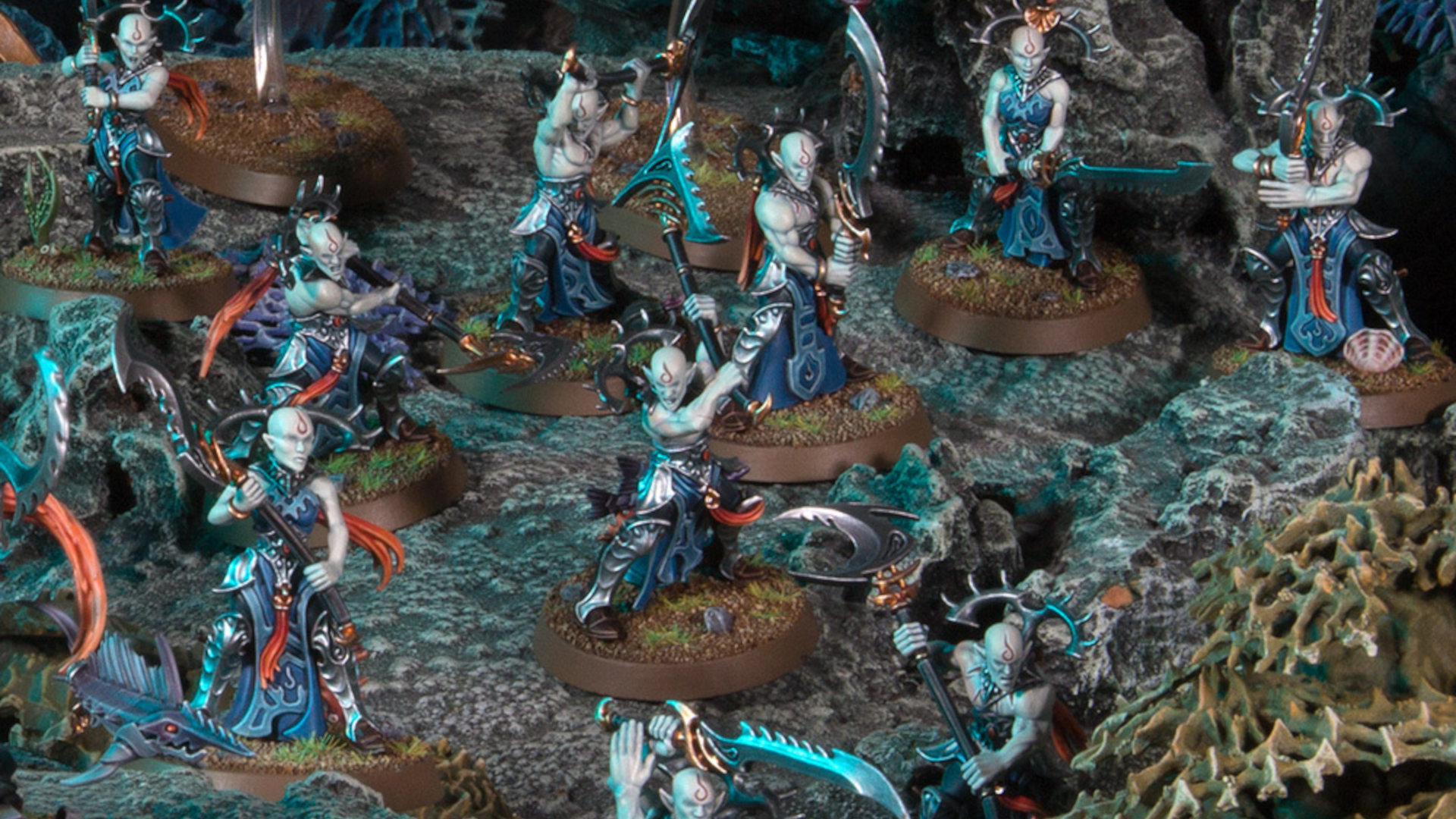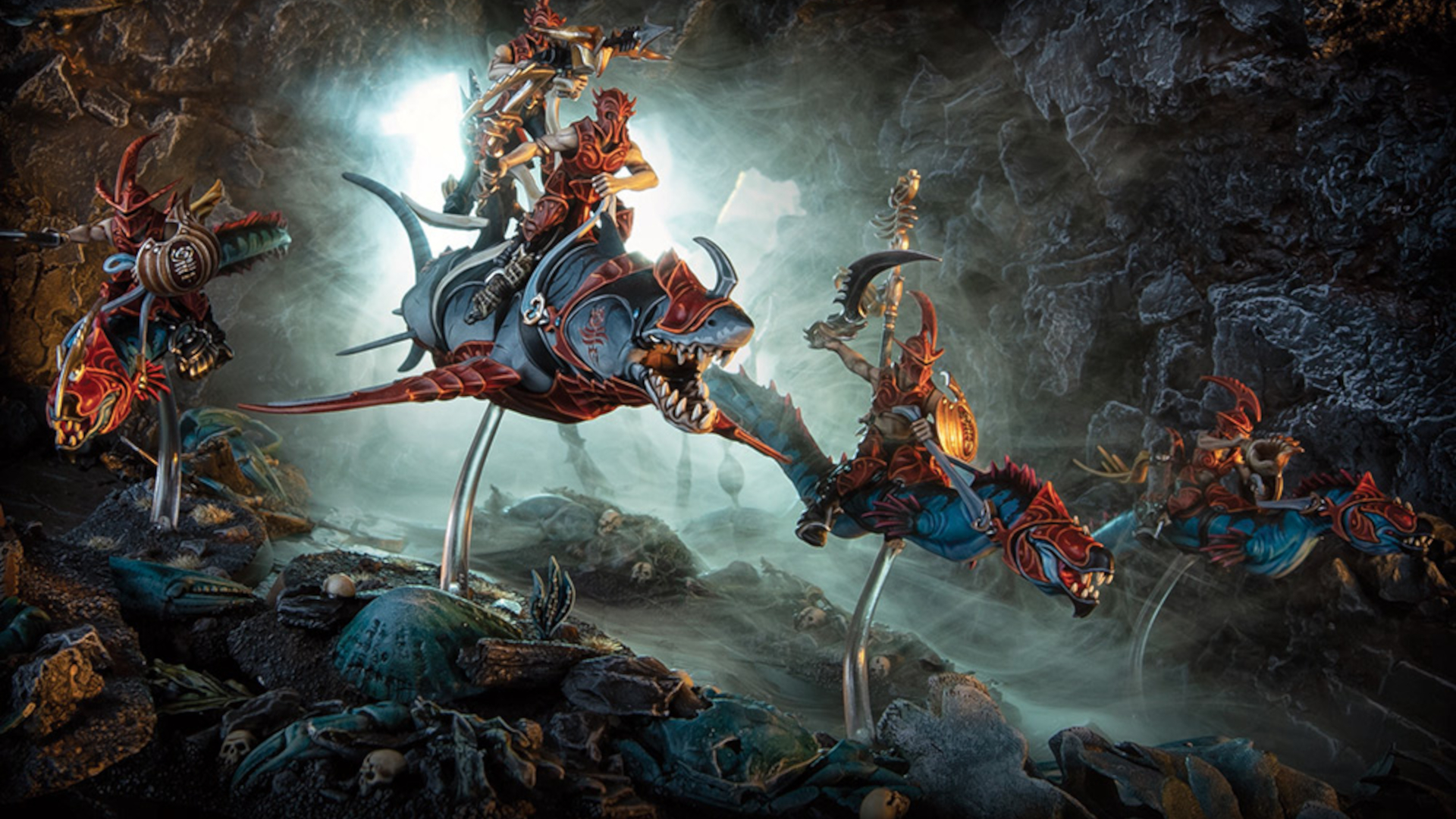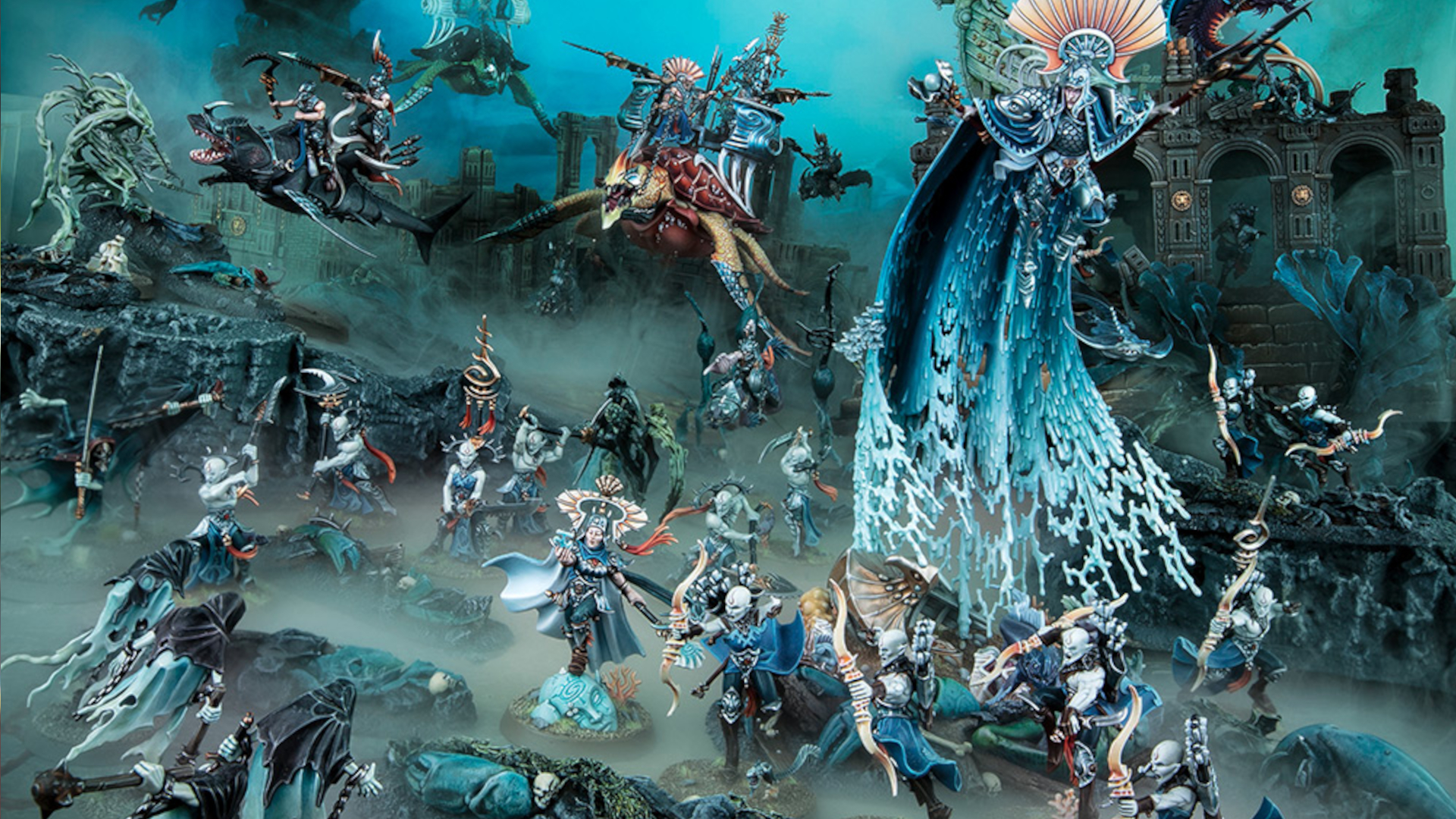From the depths of the oceans come Warhammer Age of Sigmar’s Idoneth Deepkin faction, raiders and pillagers, silent, eyeless, half-glimpsed. Riding huge, benthic predators, wielding blades of sharpened coral and shaped monster fang, their forces are buoyed by the tides of the ethersea, a magical medium that is at once air and ocean trench. They strike like a surge tide and flee like a breaking wave, taking with them the souls of their defeated foes. But why?
In the Age of Myth the elven gods searched the mortal realms in pursuit of their lost people. To their horror they found them in the gullet of the Chaos God Slaanesh. With great cunning they ensnared Slaanesh in chains of light and dark and began liberating their people’s souls into new bodies.
But the god Teclis found a troubling darkness in the heart of these new elves and nearly destroyed them. Fearing his anger and the anguish in their own ravaged souls, these firstborn elves fled into the depths of the ocean. Here they made a horrifying discovery: almost every child born would wither and die unless its soul was reinforced with soulstuff stolen from another mortal.
If you want to field an army that combines elven majesty and oceanic monstrosity, this guide to the Warhammer: Age of Sigmar Idoneth Deepkin faction will tell you all you need to know.
Namarti Thralls and Reavers
Idoneth born with withered souls are known as Namarti. They must survive several infusions of soulstuff stolen from other species to live to even a fraction of a normal elf lifespan. They are the serf caste of Idoneth society, labourers and frontline raiders in battle. Namarti are eyeless, but other senses honed in the smothering ocean mean this is no hindrance.
Both Thralls and Reavers are battleline choices in all Idoneth armies. Both are fragile, with a five plus armour save and one wound. Thralls wield the Lanmari Blade, a versatile weapon that has more attacks against targets with a single wound and does more damage against targets with three wounds or more. Reavers are faster moving and wield fast-firing Whisperbows. Though low-born serfs by elven standards, these are still accurate and deadly, hitting and wounding on three plus.
The Akhelian Thrallmaster can direct nearby Namarti in different fighting stances: the Way of the Depths allows them to re-roll hit rolls of one, while the Way of the Vortex makes them harder to wound. The Void Drum on the back of the massive Akhelian Leviadon grants all nearby Idoneth plus one to save rolls, and grants Namarti plus one to hit nearby enemies. Meanwhile the Isharann Soulrender’s Lurelight can call in the souls of the dead, returning d3 slain models to a Namarti unit at the end of the battleshock phase.
Akhelian Nobles
Idoneth who are born with souls form the noble caste of Idoneth society, the Akhelians. If you particularly like the idea of elven knights riding to battle on a mass of writhing eels, take an Akhelian King as your general.
The King is a fearsome melee combatant who rides a savage Deepmare and inspires nearby Akhelian allies with plus one to hit in melee, and turns two kinds of Akhelian knights into battleline choices. The Akhelian Ishlaen Guard are well defended by Biovoltaic Barriers which provide an unmodifiable four plus armour save that improves to three plus on the turn that they charge, while the Akhelian Morrsarr Guard wield devastating voltspears that unleash a deadly Biovoltaic Blast on the charge, inflicting mortal wounds. Both knight units ride savage Fangmora eels that strike out with fangs and lashing tails.
If you like your sea beasts even bigger, the Akhelian Allopex is a great white shark with a pair of elves manning a harpoon launcher on its back, and it’s a battleline choice in an army drawn from the Fuethán enclave. The Akhelian Leviadon is a gargantuan, six-finned sea-turtle with a whole crew of nobles on its back, a beak like an industrial car-crusher, and a battleline choice in a Nautilar army.
Idoneth Deepkin Battletome and Tactics
The Idoneth Battletome contains rules for six different Enclaves, each of which has a unique faction rule, and a mixture of relics, command traits, and spells. But by far the most important factor for the Idoneth are their Battle Traits.
The Idoneth way of war is tied to the tides of the ethersea. Forgotten Nightmares from the ocean depths, your enemies can only shoot at the closest Idoneth Deepkin unit. Use this to force your opponent into suboptimal attacks. Ishlaen Guard have unmodifiable armour saves, so enemy cannons and other rending attacks are wasted on them, while the two plus armour save of a Leviadon will laugh at a high volume of low-quality shots.
As the Tides of Death ebb and flow throughout the battle, the Idoneth’s fighting style adapts. These start at Low Tide in Battle Round One, and will progress through Flood Tide, High Tide and then Ebb Tide as the battle continues, before resetting in the fifth round. Each Tide provides a different bonus, and they are huge bonuses.
In Low Tide, Idoneth are treated as being in cover, granting plus one armour save. During Flood Tide the Idoneth gather speed, letting them shoot or charge after running. High Tide is absolutely devastating, allowing all Idoneth units to strike first in melee. Come Ebb Tide and the Idoneth fall back, and are able to shoot or charge after retreating.
High Tide might look like the be-all end-all for your army, and striking first is an undeniable advantage. But your army is relatively small, elite, and fragile. You must use your mobility, between the high speed and Fly ability on all your mounts, and the run-and-charge afforded by Flood Tide, to apply each of your units where it will do most damage. If your units are locked in combat with enemies they’re ill-equipped to face at the start of High Tide, you’ll find they are still high and dry even after they get to strike first.
Source: Wargamer







